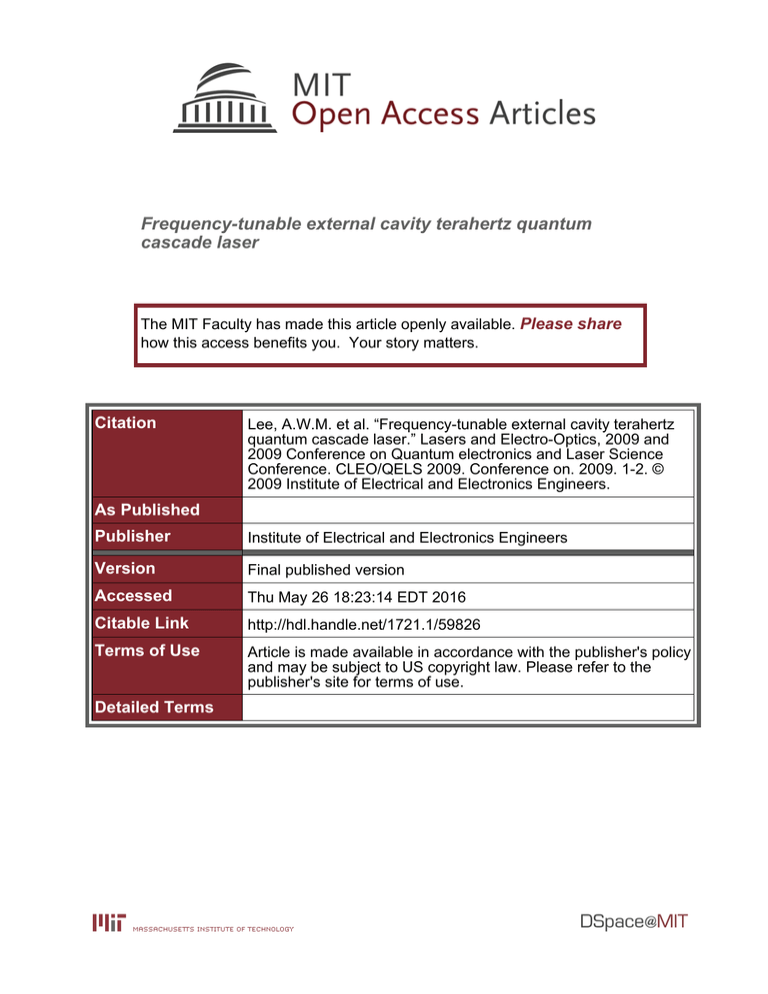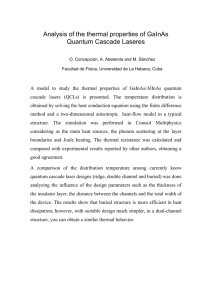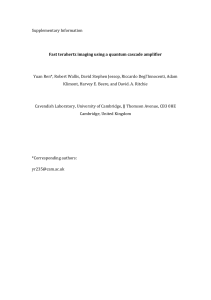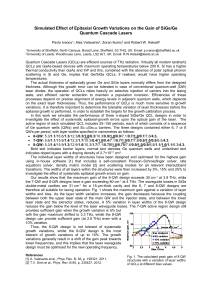Frequency-tunable external cavity terahertz quantum cascade laser Please share
advertisement

Frequency-tunable external cavity terahertz quantum cascade laser The MIT Faculty has made this article openly available. Please share how this access benefits you. Your story matters. Citation Lee, A.W.M. et al. “Frequency-tunable external cavity terahertz quantum cascade laser.” Lasers and Electro-Optics, 2009 and 2009 Conference on Quantum electronics and Laser Science Conference. CLEO/QELS 2009. Conference on. 2009. 1-2. © 2009 Institute of Electrical and Electronics Engineers. As Published Publisher Institute of Electrical and Electronics Engineers Version Final published version Accessed Thu May 26 18:23:14 EDT 2016 Citable Link http://hdl.handle.net/1721.1/59826 Terms of Use Article is made available in accordance with the publisher's policy and may be subject to US copyright law. Please refer to the publisher's site for terms of use. Detailed Terms a2732_1.pdf CThH5.pdf CThH5.pdf © 2009 OSA/CLEO/IQEC 2009 Frequency-Tunable External Cavity Terahertz Quantum Cascade Laser Alan W. M. Lee, Qi Qin, Sushil Kumar, Qing Hu Department of Electrical Engineering and Computer Science and Research Laboratory of Electronics, Massachusetts Institute of Technology, Cambridge, Massachusetts 02139 awmlee@mit.edu John L Reno Sandia National Laboratories, Center of Integrated Nanotechnologies MS 1303, Albuquerque, New Mexico 87185-1303 Abstract: We demonstrate a tunable terahertz quantum cascade laser using an abutted silicon lens and grating feedback. The device tunes discontinuously over 160 GHz with a center frequency of 4.4 THz. ©2008 Optical Society of America OCIS codes: (140.3070) Infrared and far-infrared lasers 1. Introduction Frequency tunable THz quantum-cascade lasers (QCLs) are desirable as sources for spectroscopy, imaging, and local oscillators allowing the same receiver to measure the emission from many gasses[1]. A broad tuning range is expected from these devices due to the large gain bandwidth (>0.5 THz) observed in Fabry-Perot devices. Furthermore, this bandwidth can be enhanced by engineering the quantum cascade structure to have gain at multiple wavelengths, as demonstrated in tunable mid-infrared QCLs[2]. External cavity QCLs (EC-QCLs) at THz frequencies have been demonstrated using a semi-insulating surface plasmon (SISP) waveguide with one of the cleaved facets anti-reflection (AR) coated with a λ/4 SiO2 layer with a closely spaced metal mirror for external feedback[3]. Since the external mirror is not frequency selective, the tuning is largely restricted to within a free spectral range of the external cavity (~15 GHz) before mode hopping occurs. For broadband tuning, a grating must be used. However, a large area of the grating must be illuminated for high reflection efficiency, necessitating the use of external optics to collimate the beam. Furthermore, due to cryogenic operation, placement of the grating cannot be close to the device which further necessitates collimating optics. Limitations on the optics result from requirement to efficiently couple the light reflected from the grating back into the optical mode of the SISP waveguide which has a lateral extent of approximately one freespace wavelength. This requires fast optics (<f/1) with low aberration and low optical losses. In this paper we present an SISP waveguide EC-QCL with an optically-coupled silicon hyperhemispherical lens and an external Littrow grating for optical feedback, shown in Fig. 1. The QCL is a resonant-phonon depopulation design and is 10 µm-thick, 100 µm-wide, and 1.5 mm-long. Since the aperture of the waveguide is “immersed” in silicon, the wavelength is reduce by a factor of the index of refraction (n~3.4), allowing slower optics and making the setup less sensitive to aberrations. The lens also provides a good index match to the GaAs/AlGaAs active region and GaAs substrate (n~3.6) which results in suppression of lasing in the absence of external feedback. The hyperhemispherical lens design collimates the emitted beam and is anti-reflection coated using a λ/4 layer of low density polyethylene. An echelle grating blazed for a wavelength of 118 μm is operated in the 2nd order in Littrow configuration with has a calculated reflectivity of ~40% at the lasing wavelength of 70 μm. The laser output is taken from the opposite cleaved facet. The frequency tuning results of the device are shown Fig. 2 operating with 400 ns pulses for an overall duty cycle of 2%, at 30K the temperature of a closed cycle pulse tube cryorefrigerator. The total tuning range is 160 GHz with a center frequency of 4.4 THz for a total tuning range of 3.6%. However frequency hopping is observed between the longitudinal modes of the device spaced at 26 GHz (neff=3.84). Even though lasing is suppressed in the absence of feedback, it is likely that the lens does not provide a perfect anti-reflection coating due to mismatch of the optical mode and/or small gaps between the lens and the device. Improved tuning bandwidth and continuous tuning should be possible with the addition of stronger, more frequency selective optical feedback. Future devices based on the EC-QCL such as amplifiers are possible based on the lens-coupled design. 978-1-55752-869-8/09/$25.00 ©2009 IEEE a2732_1.pdf CThH5.pdf CThH5.pdf © 2009 OSA/CLEO/IQEC 2009 This work is supported by AFOSR, NASA and NSF. Sandia is a multiprogram laboratory operated by Sandia Corporation, a Lockheed Martin Company, for the United States Department of Energy's National Nuclear Security Administration under Contract DE-AC04-94AL85000. Fig. 1: EC-QCL: Semi-insulating surface plasmon waveguide THz QCL, mounted on a copper block abutted to a high-resistivity silicon hyperhemispherical lens with a grating for external feedback. Fig. 2: Pulsed lasing spectra from EC-QCL (offset for clarity). Spectra taken at various grating angles at 1 A (670 A/cm2) and 30 K. References 1. Gao, J.R., et al., Terahertz heterodyne receiver based on a quantum cascade laser and a superconducting bolometer. Applied Physics Letters, 2005. 86(24): p. 244104 -. 2. Maulini, R., et al., External cavity quantum-cascade laser tunable from 8.2 to 10.4 mu m using a gain element with a heterogeneous cascade. Applied Physics Letters, 2006. 88(20): p. 201113-3. 3. Xu, J., et al., Tunable terahertz quantum cascade lasers with an external cavity. Applied Physics Letters, 2007. 91(12): p. 1-3.





